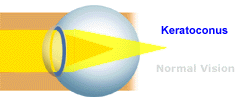Keratoconus is a vision disorder that occurs when the normally round cornea (the front part of the eye) becomes thin and irregular (cone) shaped. This abnormal shape prevents the light entering the eye from being focused correctly on the retina and causes distortion of vision. In its earliest stages, keratoconus causes slight blurring and distortion of vision and increased sensitivity to glare and light. These symptoms usually appear in the late teens or late 20s. Keratoconus may progress for 10-20 years and then slow in its progression. Each eye may be affected differently. As keratoconus progresses, the cornea bulges more and vision may become more distorted. In a small number of cases, the cornea will swell and cause a sudden and significant decrease in vision. The swelling occurs when the strain of the cornea's protruding cone-like shape causes a tiny crack to develop. The swelling may last for weeks or months as the crack heals and is gradually replaced by scar tissue. If this sudden swelling does occur, your doctor can prescribe eyedrops for temporary relief, but there are no medicines that can prevent the disorder from progressing.
Eyeglasses or soft contact lenses may be used to correct the mild nearsightedness and astigmatism that is caused by the early stages for keratoconus. As the disorder progresses and cornea continues to thin and change shape, specialty contact lenses can be prescribed to correct vision adequately. In most cases, this is sufficient. The contact lenses must be carefully fitted, and frequent checkups and lens changes may be needed to achieve and maintain good vision. Dr. Fry is very experienced in fitting keratoconus patients with special contact lenses and has the proper equipment to track the progression of the disease.
adequately. In most cases, this is sufficient. The contact lenses must be carefully fitted, and frequent checkups and lens changes may be needed to achieve and maintain good vision. Dr. Fry is very experienced in fitting keratoconus patients with special contact lenses and has the proper equipment to track the progression of the disease.
In a few cases, a corneal transplant is necessary. However, even after a corneal transplant, eyeglasses or contact lenses are often still needed to correct vision. (AOA website)
Dr. Fry utilizes the latest equipment to detect keratoconus and the latest products and procedures to obtain the best outcome for his keratoconus patients. Current treatment includes UltraHealth lenses from Synergeyes, RGPs designed for keratoconus, and scleral lenses. Corneal Cross-Linking is available utilizing our referral relationship with the Woolfson Eye Institute. (http://www.woolfsoneye.com/keratoconus/)







